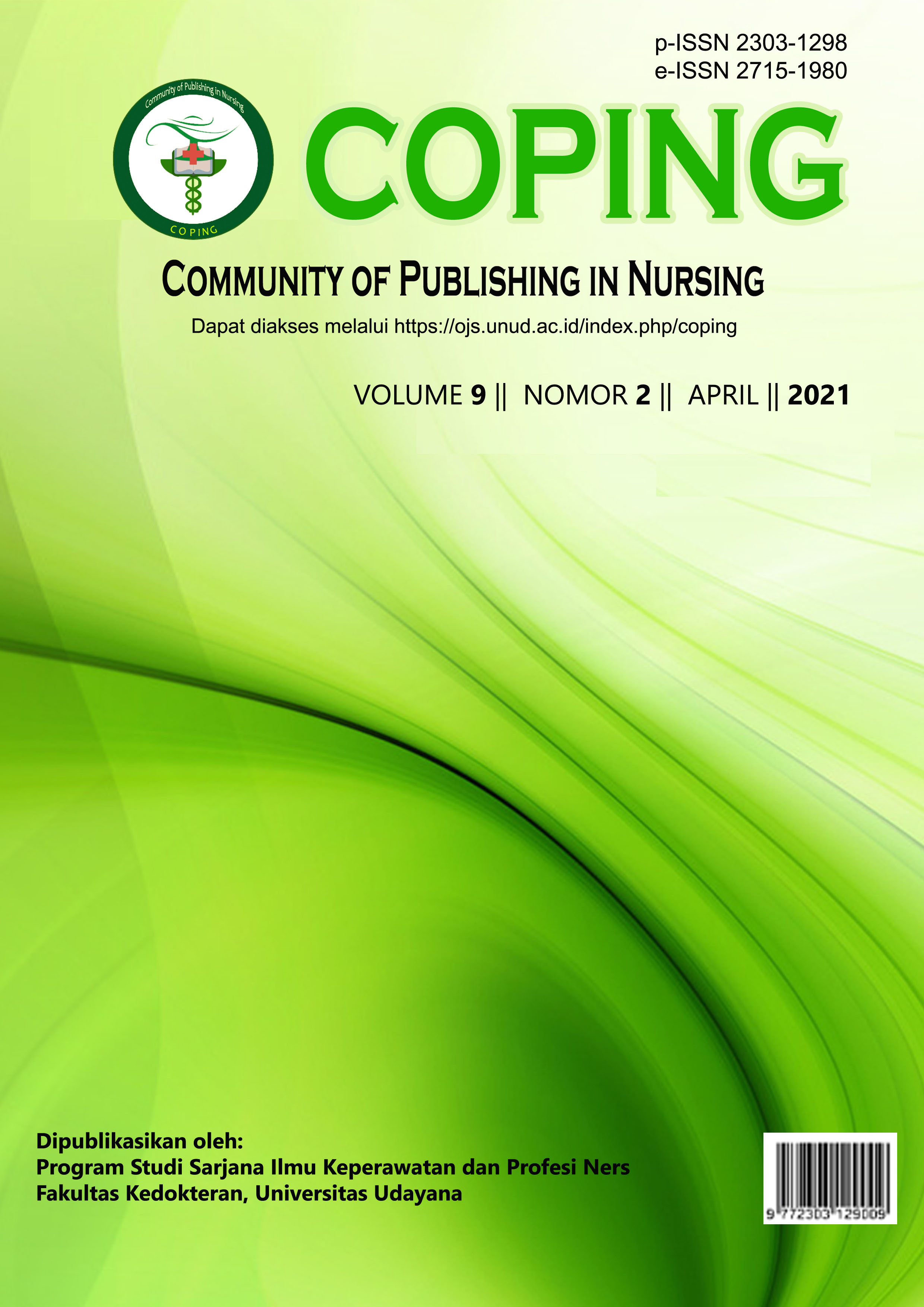PENGARUH STUNTING SMART CHATTING TERHADAP PENGETAHUAN DAN SIKAP IBU DENGAN BALITA DI DESA PERING KECAMATAN BLAHBATUH KABUPATEN GIANYAR
Abstract
Improving knowledge and attitudes about stunting among mother with toddler through health education can play an important role as an effort to decrease the incidence of stunting. Stunting Smart Chatting is one of mHealth media that can be used in the process of providing health education. This study aimed to determine the effect of Stunting Smart Chatting on knowledge and attitudes about stunting among mothers in Pering Village, Blahbatuh District, Gianyar Regency. This study was a quasi-experimental with a pretest-posttest one group design. Samples were selected using simple random sampling and were given messages through WhatsApp-based short messages sent three times a week for three weeks duration. Paired t-test and Wilcoxon test were used in this study. Statistical tests indicated that there were differences in knowledge (p=0,001) and attitude (p<0,001) before and after the intervention. Based on these results, it can be concluded that Stunting Smart Chatting can improve the knowledge and attitudes about stunting among mothers with toddlers in Pering Village, Blahbatuh District, Gianyar Regency. The Stunting Smart Chatting as a health education media is recommended to be used in a community setting.
Downloads
References
Azwar, S. (2016). Sikap Manusia Teori Dan Pengukurannya. 2nd ed. Yogyakarta: Pustaka Pelajar.
Bensley, R. J. & Brookins-Fisher, J. (2003). Metode Pendidikan Kesehatan Masyarakat. 2nd ed. Jakarta: Buku Kedokteran EGC.
Cicih, L. H. M. (2011). Pengaruh Perilaku Ibu Terhadap Status Kesehatan Anak Baduta Di Provinsi Jawa Tengah. Jurnal Sari Pediatri, XIII(1).
Efendi, F. & Makhfudli. (2009). Keperawatan Kesehatan Komunitas Teori Dan Praktik Dalam Keperawatan. Jakarta: Salemba Medika.
Fitriani, S. (2011). Promosi Kesehatan. 1st ed. Yogyakarta: Graha Ilmu.
Herlina, S., Sanjaya, G. Y. & Emilia, O., (2013). Pemanfaatan Fasilitas SMS Telepon Seluler Sebagai Media Promosi Kesehatan Ibu Hamil Di Daerah Terpencil. Seminar Nasional Sistem Informasi Indonesia.
Hitatami, E. et al., (2014). Pengaruh Pendidikan Kesehatan Tentang Kehamilan Resiko Tinggi Melalui Layanan Pesan Singkat Terhadap Peningkatan Pengetahuan Dan Sikap Ibu Hamil. Indonesian Journal Of Educational and Midwifery Care I(1):49–55.
Kementrian Kesehatan Republik Indonesia. (2018a). Cegah Stunting Dengan Perbaikan Pola Makan, Pola Asuh Dan Sanitasi. Retrieved (http://www.depkes.go.id/article/view/18040700002/cegah-stunting-dengan-perbaikan-pola-makan-pola-asuh-dan-sanitasi-2-.html).
Kementrian Kesehatan Republik Indonesia. (2018b). Situasi Balita Pendek (Stunting) Di Indonesia. Jakarta: Pusat Data dan Informasi.
Kementrian Komunikasi dan Informatika Republik Indonesia. (2017). Survey Penggunaan TIK Tahun 2017. Jakarta: Pusat Penelitian dan Pengembangan Aplikasi Informatikadan Informasi dan KomunikasiPublik.
Nopriani, N. L. P., Damayanti, M. R., Manangkot, M. V. & Rahajeng, I. M., (2019). Improving Mother’s Mosquito Eradication Behavior Through A Text-Messaging Based Intervention: Dengue Chit-Chat in Bali. International Journal of BioScience and Applications I(1):1–5.
Notoatmodjo, S. (2010). Ilmu Perilaku Kesehatan. Jakarta: Rineka Cipta.
Nundy, S., Dick, J., Solomon, M. C., & Peek, M. E. (2012). Developing a Behavioral Model for Mobile Phone-Based Diabetes Interventions. Patient Education and Counseling XC:125–32.
Olsa, E. D., Sulastri, D. & Anas, E., (2017). Hubungan Sikap Dan Pengetahuan Ibu Terhadap Kejadian Stunting Pada Anak Baru Masuk Sekolah Di Kecamatan Nanggalo. Jurnal Kesehatan Andalas III(6):523–29.
Orr, J. A. & King, R, J., (2015). Mobile Phone SMS Message Can Enchance Healthy Behaviour: A Meta-Analysis of Randomised Controlled Trial. Health Psychology Review IX(4):397–416.
Pine, K. J., & Fletcher, B., (2015). It Started with a Text: An Analysis of the Effectiveness of MHealth Interventions in Changing Behavior and the Impact of Text Messaging on Behavioural Outcomes. mHealth White Paper.
Ramayulis, R., Kresnawan, T., Iwaningsih, S. & Rochani, N. S., (2018). Stop Stunting Dengan Konseling Gizi. Jakarta: Penebar Plus.
Riskesdas. (2018). Riset Kesehatan Dasar Tahun 2018. Jakarta.
Suryagustina, Araya, W. & Jumielsa. (2018). Pengaruh Pendidikan Kesehatan Tentang Pencegahan Stunting Terhadap Pengetahuan Dan Sikap Ibu Di Kelurahan Pahandut Palangka Raya. Jurnal Kebidanan Dan Keperawatan IX(2):582–91.
Tang, Y., & Hew, K. F., (2017). Is Mobile Instant Messaging (MIM) Useful in Education? Examining Its Technological, Pedagogical, and Social Affordances. Educational Research Review.
Vital Wave Consulting. (2009). mHealth for Development: The Opportunity of Mobile Technology for Healthcare in the Developing World. Washington DC: United Nation Foundation.
World Health Organization. (2015). Stunting in a Nutshell. Retrieved (https://www.who.int/nutrition/healthygrowthproj_stunted_videos/en/#).
Yani, A., (2018). Pemanfaatan Teknologi Dalam Bidang Kesehatan Masyarakat. Jurnal Kesehatan Masyarakat VIII(1): 97–102.
Yani, A., Suriah, & Jafar, N., (2017). Pengaruh SMS Reminder Terhadap Perilaku Ibu Hamil Mengkonsumsi Tablet Fe. The Indonesian Journal of Public Health XIII(1):12–20.







